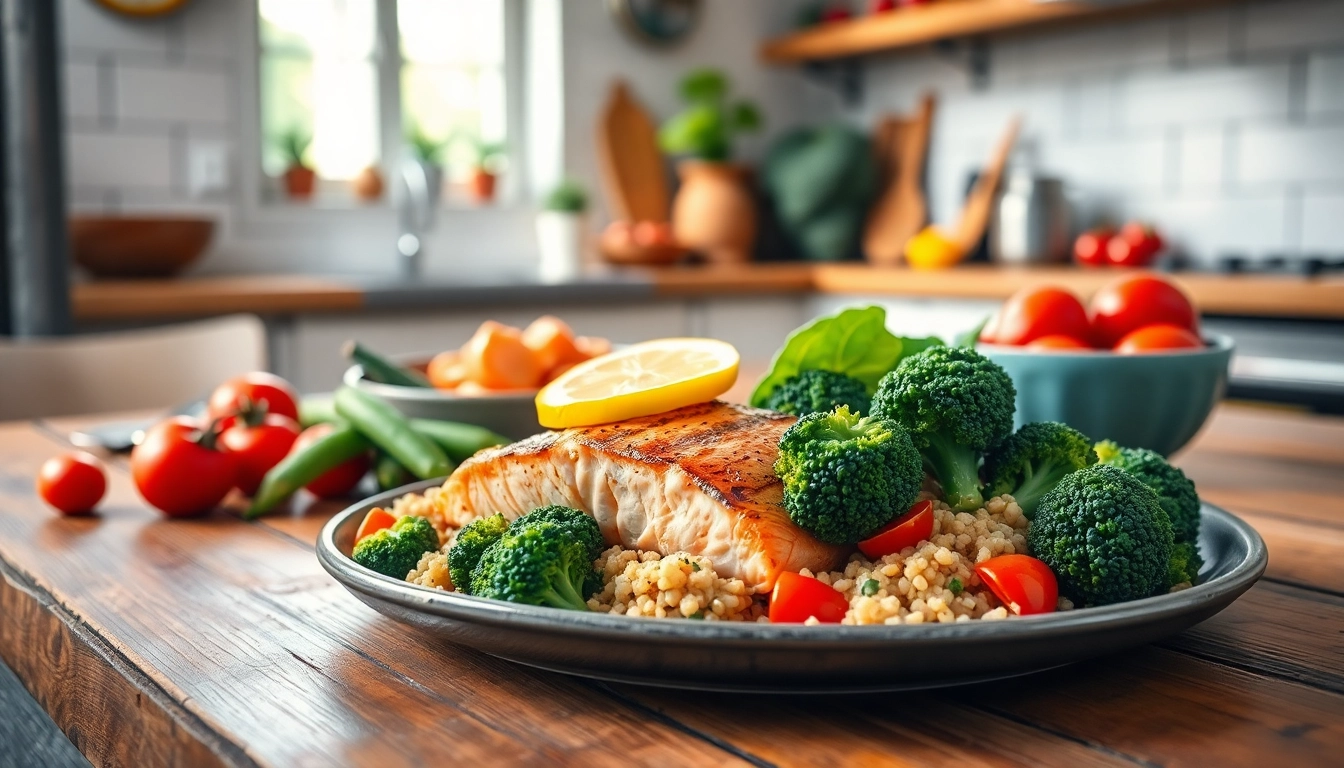
Understanding Healthy Dinner Meals to Lose Weight
When it comes to achieving weight loss goals, one of the most crucial factors to consider is nutrition. While many focus primarily on daily calorie intake or exercise, the importance of healthy dinner meals to lose weight cannot be overstated. The dinner meal can significantly impact your health, metabolism, and overall diet plan. In this comprehensive guide, we will explore the significance of healthy eating, debunk common dinner-related myths, and identify key ingredients that can help transform your dinner into a weight-loss booster.
Defining Healthy Eating
Healthy eating encompasses more than merely counting calories; it involves choosing foods that provide essential nutrients, promote energy, and support overall well-being. The goal is to achieve a balanced diet comprising macronutrients (proteins, fats, and carbohydrates) and micronutrients (vitamins and minerals). A diet rich in whole foods—vegetables, fruits, lean proteins, and whole grains—provides the body with the nutrients it requires for optimal functioning. Healthy eating also includes cooking methods such as steaming, grilling, and baking, which preserve the nutrient value of food.
Importance of Dinner in Weight Loss
Dinner plays a pivotal role in our daily dietary habits and can greatly influence our weight management journey. Many overlook the dinner meal, believing that skipping it may help with weight loss. However, research indicates that having a structured meal in the evening can prevent overeating during later hours and reduce late-night snacking. Moreover, a well-planned dinner can stabilize blood sugar levels, aiding metabolism and promoting fat loss. The timing of your evening meal also matters; having dinner earlier in the evening can enhance digestion and support better metabolic function.
Common Myths About Dinner and Weight Loss
Misconceptions about dinner and weight loss abound. One prevalent myth is that eating after a certain time—typically after 7 PM—will cause weight gain. However, weight gain occurs when there is a caloric surplus, regardless of the time of consumption. Another common myth is that dinner should be the lightest meal of the day; in reality, a balanced dinner can be satiating and nutritious. Individuals often believe that certain foods are ‘off-limits’ for dinner, such as carbs or fats, but healthy fats and complex carbohydrates can be integral parts of a weight-loss-friendly meal.
Key Ingredients for Healthy Dinner Meals to Lose Weight
Crafting healthy dinner meals centers on selecting the right ingredients. Here are essential components that should feature in your dinner plate to optimize weight loss.
Lean Proteins: Choosing the Right Options
Protein is crucial not just for muscle repair and building but also in managing hunger. Lean protein options such as chicken breast, turkey, fish, tofu, and legumes should occupy a prominent place on your dinner plate. They are lower in saturated fat compared to their fatty counterparts and provide the necessary amino acids that our bodies need while aiding in weight loss by promoting satiety. Studies suggest that a higher protein intake increases feelings of fullness, helping to reduce subsequent calorie consumption.
Vegetables: The Colorful Powerhouses
Vegetables should be the star of your healthy dinner meals. Not only do they add thick texture and vibrant color, but they are also packed with vitamins, minerals, and dietary fiber, which can keep cravings at bay. Aim to fill half your plate with a variety of vegetables—spinach, bell peppers, broccoli, and cauliflower are excellent choices. The more colorful the plate, the more antioxidants and nutrients you consume. Additionally, high-fiber vegetables help regulate digestion and contribute to feelings of fullness.
Whole Grains and Healthy Fats
Whole grains such as quinoa, brown rice, and whole wheat pasta provide complex carbohydrates that release energy slowly, promoting stable blood sugar levels. Incorporating healthy fats—such as avocados, nuts, seeds, and olive oil—can further enhance the nutritional profile of your dinner. Healthy fats are essential for the absorption of fat-soluble vitamins and offer a satisfying mouthfeel that can help curb sugar cravings. Pairing whole grains and healthy fats with lean proteins and vegetables can create a well-rounded, balanced meal.
Easy Recipe Ideas for Healthy Dinner Meals to Lose Weight
Now that we’ve reviewed the key components for a healthy dinner, let’s delve into easy and delicious recipe ideas that incorporate these elements.
Light and Flavorful Grilled Dishes
Grilling not only brings out incredible flavors but also reduces the need for excess oil and butter. Consider trying a grilled lemon herb chicken breast paired with grilled zucchini and bell peppers. Marinate the chicken in lemon juice, garlic, and your choice of herbs for a delicious, low-calorie meal.
Another grilled option could be a salmon filet grilled with a honey-mustard glaze served alongside asparagus. Salmon is packed with omega-3 fatty acids, promoting heart health while being a fantastic protein source.
One-Pan Meals for Quick Prep
When time is of the essence, one-pan meals simplify the cooking process. A classic example could be a one-pan chicken and vegetable bake, featuring skinless chicken thighs, sweet potatoes, carrots, and Brussels sprouts. Season with olive oil, garlic, and herbs. The roasting method enhances natural flavors and retains moisture without adding unnecessary calories.
Another standout is a quinoa and vegetable stir-fry, which comes together quickly and is bursting with color and nutrients. Throw in bell peppers, green beans, and snap peas with cooked quinoa and a light soy sauce for a filling meal.
Salads that Satisfy
Salads need not be bland or boring. A mixed greens salad topped with grilled shrimp, avocado, sliced almonds, and a light vinaigrette offers a satisfying and nutrient-dense meal option. Similarly, a chickpea salad with red onion, cucumber, and a squeeze of lemon juice provides both protein and dietary fiber, staving off hunger. You can boost your salads’ satiety by adding a variety of textures, such as roasted seeds or croutons made from whole-grain bread.
Meal Planning Strategies for Healthy Dinner Meals to Lose Weight
Effectively planning your meals is one of the most reliable strategies for maintaining a healthy diet and achieving weight loss. Here are some key strategies.
Creating a Balanced Weekly Menu
Establish a weekly menu that includes diverse meals focusing on lean proteins, vegetables, whole grains, and healthy fats. Begin by setting aside time each week to outline meals, taking care to incorporate a variety of flavors and textures to keep boredom at bay. A well-planned menu reduces impulsive eating and ensures that you have the needed ingredients on hand.
Batch Cooking for Efficiency
Batch cooking is a powerful time-saver and helps in sticking to healthy habits. Devote a few hours to preparing large quantities of grains, proteins, and vegetables, storing them for quick access throughout the week. For instance, roast a large batch of chicken breasts and cook a pot of brown rice that can easily be reheated and combined with different seasonings or sauces for varied meals.
Shopping Tips for Healthy Ingredients
When grocery shopping, prioritize fresh, whole foods. Create a shopping list organized by categories—fruits, vegetables, proteins, grains, and fats—to streamline the process and avoid impulse purchases of unhealthy options. Start your shopping in the produce section, which ensures that you have plenty of colorful vegetables and fruits to choose from, making healthy meal preparation easier.
Tracking Progress with Healthy Dinner Meals to Lose Weight
Monitoring your progress can provide valuable insights into your eating habits and overall health. Here’s how to effectively track your journey.
Setting Realistic Goals
When embarking on a weight-loss journey, it’s crucial to set achievable goals. Rather than focusing solely on the number on the scale, aim for non-scale victories, such as improved energy levels, better sleep quality, or fitting into your clothes more comfortably. Set guidelines like cooking more home-made meals or incorporating a new vegetable each week to shift your focus to lifestyle changes.
Using Food Journals for Accountability
Journaling can be an effective tool for tracking what you eat and understanding your eating patterns. Keeping a food diary holds you accountable for your food choices and can highlight areas for improvement. Document not just what you consume, but how you feel before and after meals. This awareness can aid in recognizing emotional eating triggers and help establish a healthier relationship with food.
Adjusting Meals Based on Results
As you monitor dietary changes and progression, be open to adjusting your meals based on what’s working and what isn’t. If certain meals leave you feeling unsatisfied or hungry, explore adding more fiber-rich foods or proteins. Similarly, if you notice a lack of progress, reassess portion sizes or consider increasing physical activity to complement your dietary efforts.
Incorporating healthy dinner meals to lose weight into your lifestyle is a process that involves understanding nutrition, being mindful of food choices, and committing to preparation. With the right strategies and delicious recipes, every dinner can become an opportunity to nourish your body while working towards your weight-loss goals.






